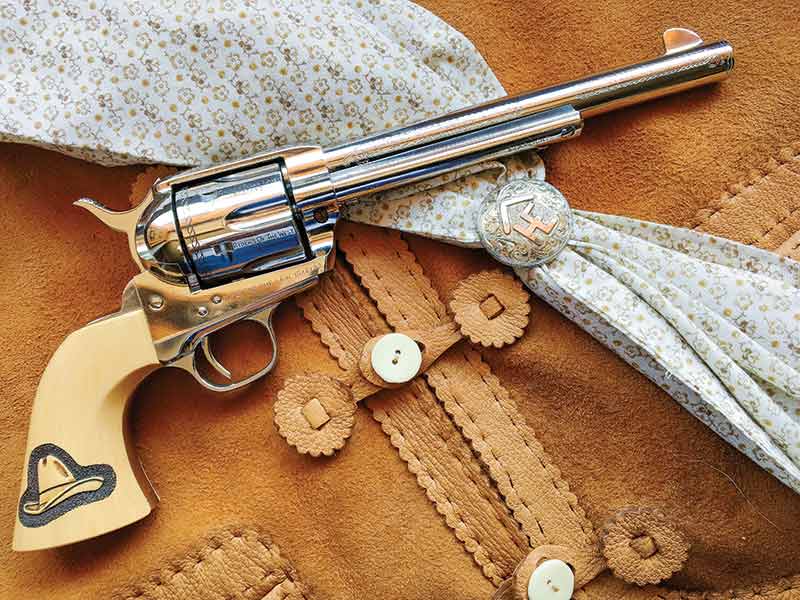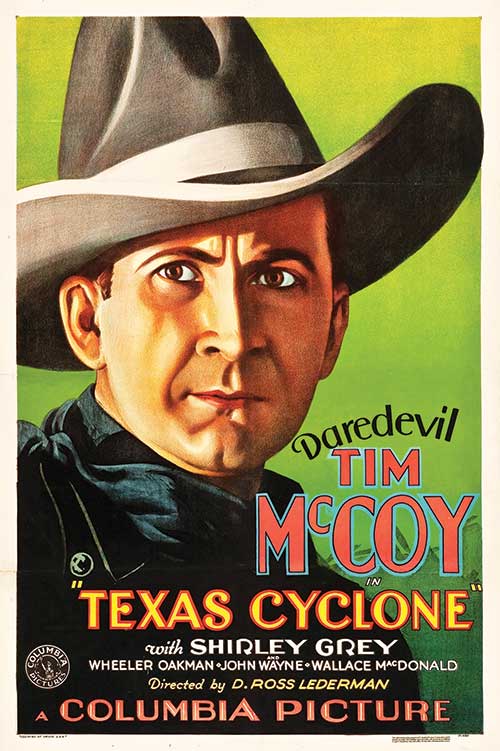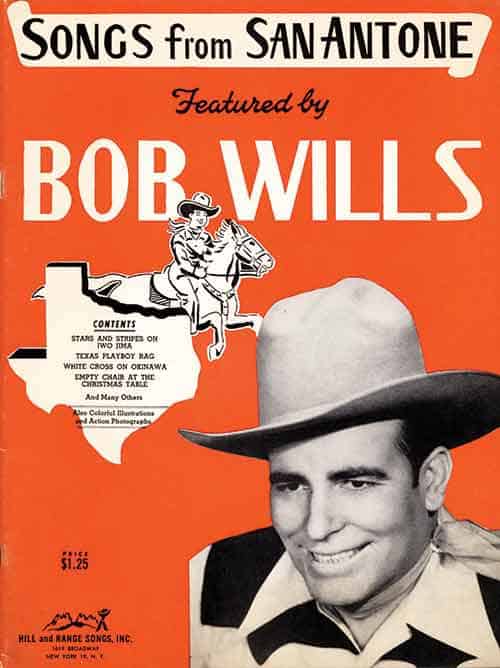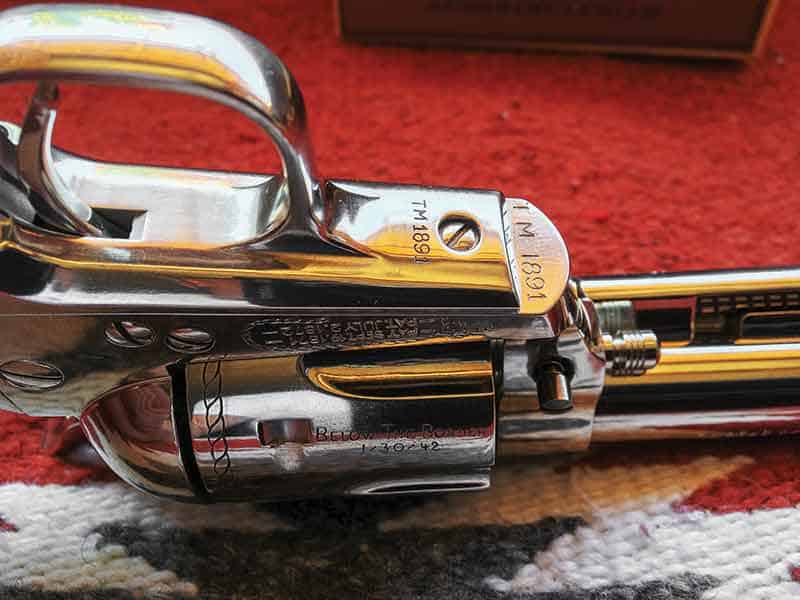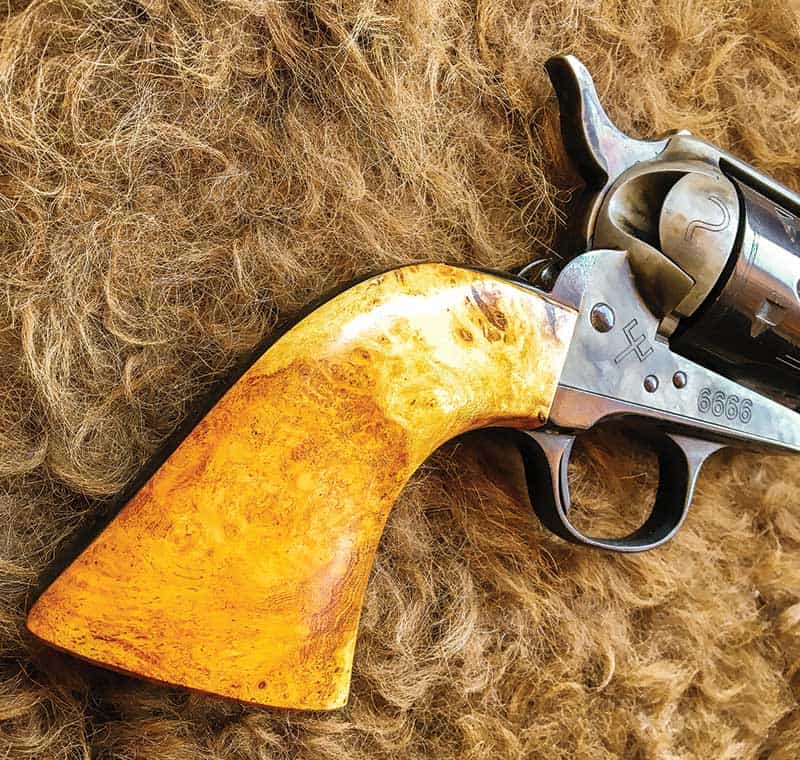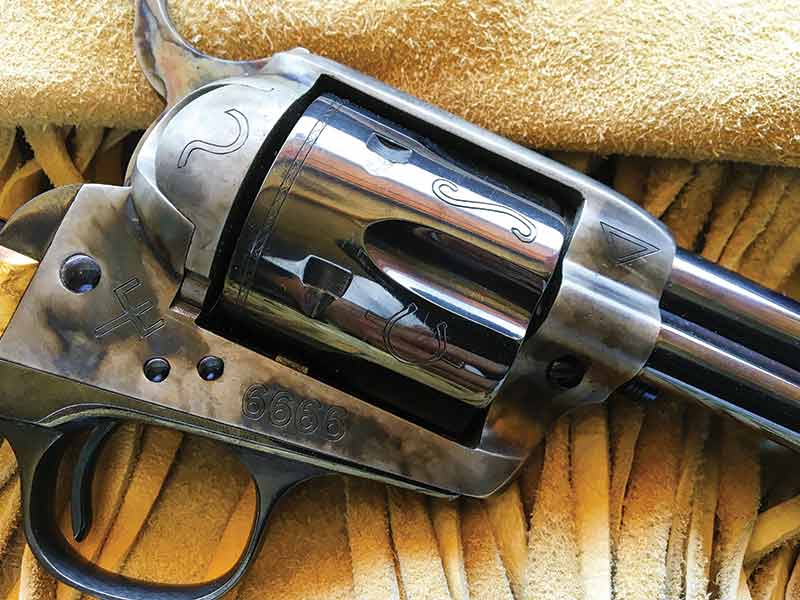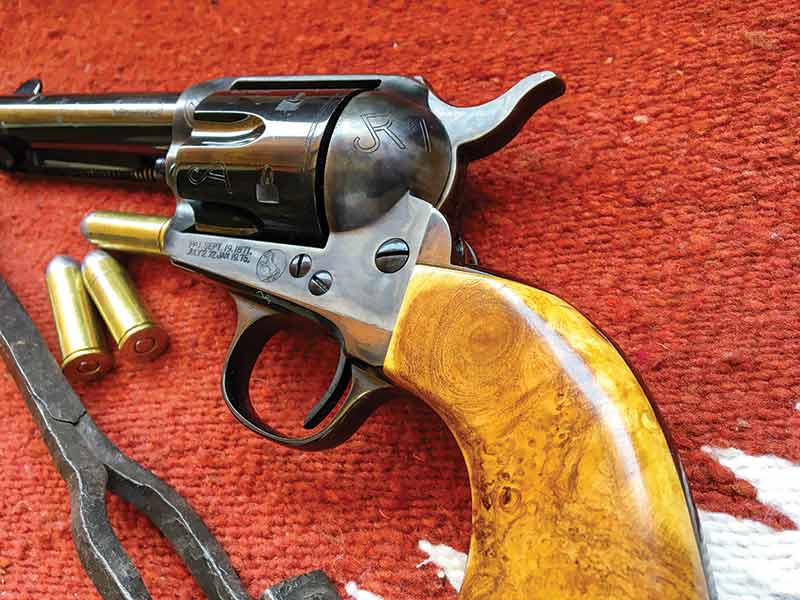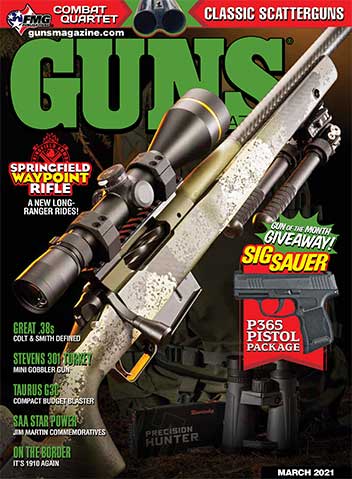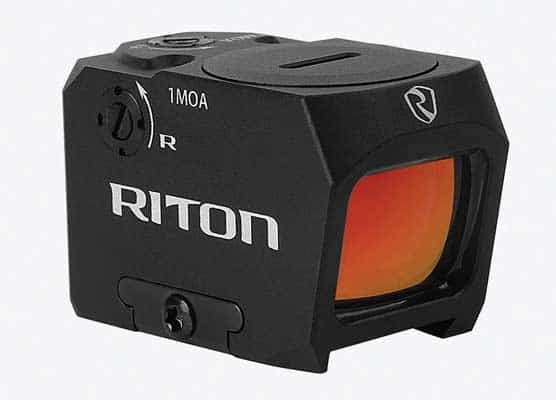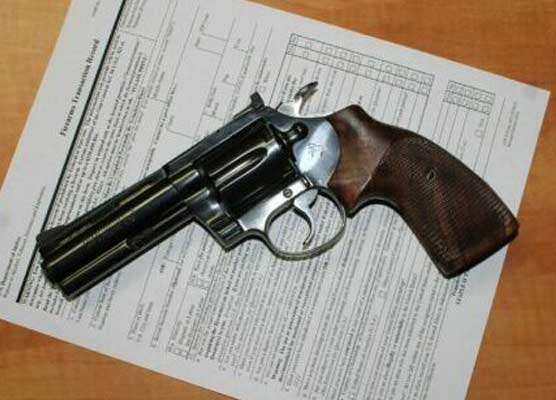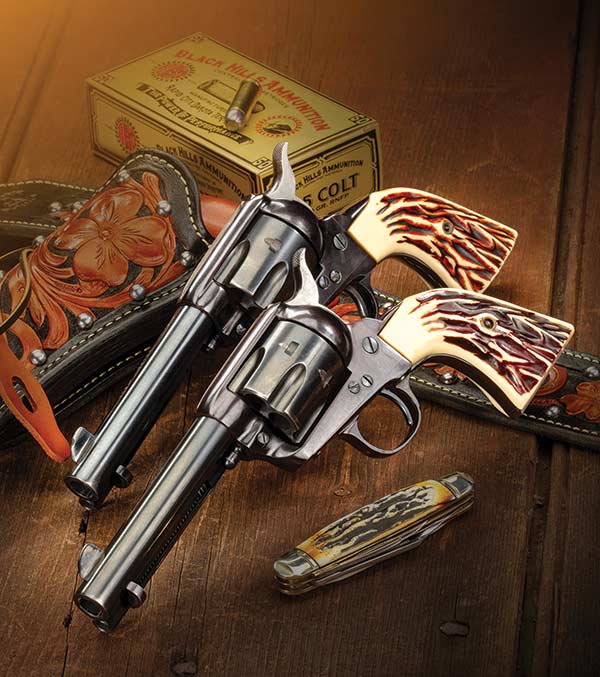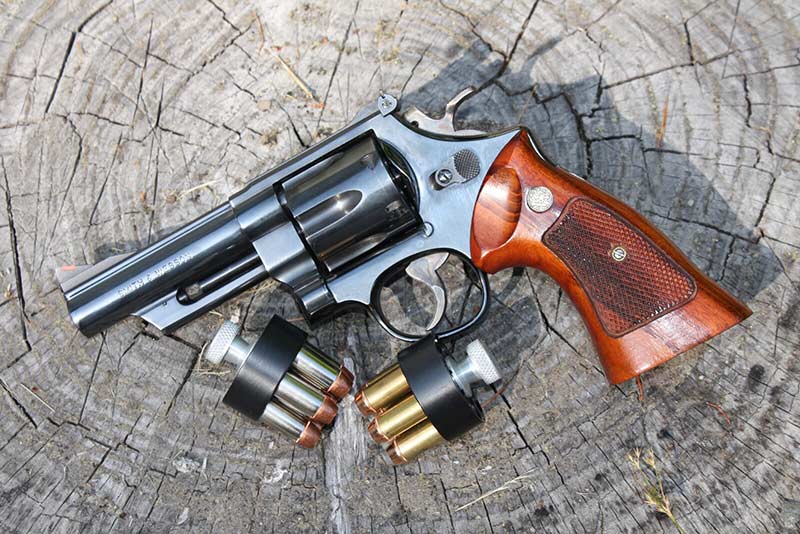Jim Martin Tribute Revolvers
A Steel (EM)Brace Of Western Entertainment History
Jim Martin is legendary. He has won countless fast-draw awards, holds shooting records, has advised movie stars on gun-handling and stood in during fast-draw clips for movies and television shows. He has amazed audiences using the twirls of a drum major combined with the nimble-fingered moves of a vaudeville juggler.
His ability with a Colt single-action revolver isn’t limited to trick shooting and fast-draw contests. Martin is also a magician in making Colt Peacemaker actions as smooth as Tennessee whiskey. For a half century, gun importers and manufacturers have sought his wisdom and many Colt aficionados consider Jim Martin to be the top Colt gunsmith, bar none.
While Martin is a demi-god wherever Colt Single Action Army is spoken, he too has heroes — men who influenced his childhood on the silver screen and whose images decorate his home to this day.
Coming from humble rural beginnings, they punched wild-eyed cattle, pulled leather breaking broom-tail mustangs and ended up winning America’s hearts on the silver screen and radio airways. So, what does master craftsman Jim Martin do to honor his heroes? He immortalizes them in Colt steel!
Tim McCoy — Movie Star
To learn Timothy John Fitzgerald McCoy — “Tim McCoy” — is one of Jim Martin’s heroes comes as no surprise. While the life of Tim McCoy is too complex to fully cover, he was a man worthy of emulation.
Inspired by Buffalo Bill’s Wild West Show he took a train west, ending up breaking horses in Nebraska then drifting into Wyoming to work on cattle ranches. In 1909 cattle drives, rustling and range wars were still a thing.
While riding the range, McCoy often met Arapahoe Indians. Unlike most cowboys, McCoy wanted to get to know the tall, quiet Arapahos and made it a priority to learn their universal sign language.
McCoy’s relationship with the Arapaho blossomed into powerful friendships as he became entwined in their beautiful and complex culture. At the time, many of the warriors who fought against Custer were still alive and McCoy listened to their stories of the old ways. McCoy became like a son or nephew to many of the old warriors and was even adopted into the tribe. Because of his bravery and friendship, they gave him the name High Eagle, an honor McCoy treasured to his deathbed.
The movie industry was still in its fledgling stage. A Hollywood production company wanted to make an epic about the old wagon trains and needed Indians, lots of them. Word of Tim McCoy and his friendship with the Arapaho had reached Hollywood so he was approached with the idea of hiring hundreds of Indians as extras. McCoy agreed, provided the Arapaho were treated with respect and compensated fairly.
Eventually, the movie producers didn’t just want Arapahos in their movies — they wanted an authentic cowboy. Tim McCoy was it.
McCoy shared the screen with John Wayne, Walter Brennen and Buck Jones. McCoy’s steely-eyed stare, tall, wide-brimmed hat, and quick draw earned him the admiration of countless children (and adults) across America — so much so Wheaties featured McCoy on their cereal box.
McCoy was authentic in his shooting ability and lightning on the draw. He was captured on film drawing and firing in 0.25 seconds.
After a stint in the army in WWII, McCoy gave up acting, sold his Wyoming ranch, moved east, and then southwest to the Nogales, Arizona region. He passed away at the age of 86 on January 29, 1978.
Jim Martin’s tribute revolver touches on some of the highlights of Tim McCoy’s life. Movie names and dates are emblazoned on the cylinder, frame and barrel. Two of the military medals McCoy was awarded are engraved on the top of the frame. McCoy’s Rafter H-E Connected brand, his full name, birth and death dates as well as “High Eagle,” McCoy’s
Arapaho name, decorate the back strap. The grips feature a relief of McCoy’s signature hat and the head of an eagle.
Like the life of Tim McCoy, the revolver is an amalgamation. The frame, trigger guard and back strap were manufactured for American Western Arms. The barrel, cylinder and inner workings are Second Generation Colt SAA components. The imitation antique ivory grips were made by Martin with Bar S Tru Ivory and cut to a flat bottom configuration to provide a natural pointing ability for hip shooting. The nickel-plated revolver sports a 7.5″ barrel and is chambered in .44 Special.
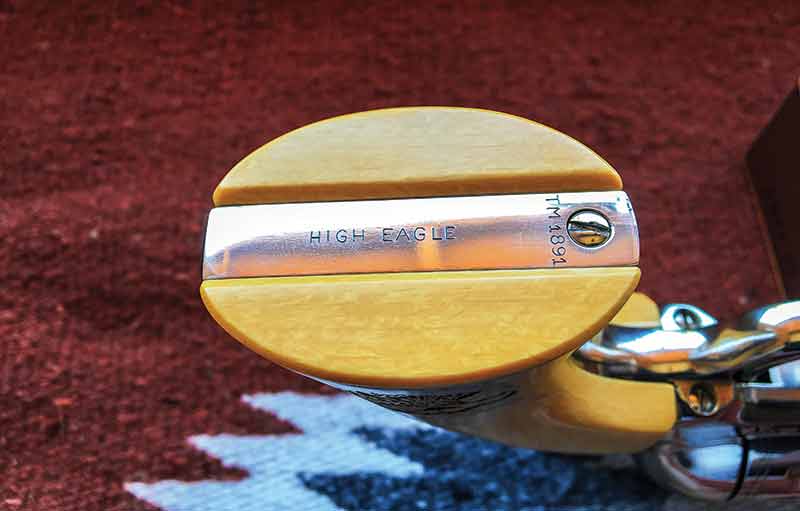
Tim McCoy had an intimate relationship with members of the Arapaho tribe.
For his friendship, honesty and bravery they named him High Eagle. It was an
honor he cherished and worked into his cattle brand — Rafter HE Connected.
Left, McCoy made over 80 films, many featuring his signature wide-brimmed,
7½" crown hat, appropriately highlighted on the right stock of the Martin-crafted Colt.
Bob Wills — King of Western Swing
Immortalized in song and film, Bob Wills needs little introduction.
James Robert (Bob) Wills was born in east-central Texas in 1905 to a cotton farming family. Growing and picking cotton was back-breaking work under the hot Texas sun. Relief from the drudgery came in the form of local dances, at which John Wills, Bob’s father was in constant demand. At an early age, Bob followed in his father’s footsteps and learned to play the mandolin as well as the fiddle.
Growing cotton rapidly depletes farmland and by 1913 the Wills family had moved to Hall County in the Panhandle of Texas. The talents of Bob’s family were in constant demand and if they weren’t playing dances elsewhere, they were hosting dances at their humble home. Learning to play fiddle and other instruments, he started performing at a young age. The siren call of adventure pulled Bob away from home at the age of 16 and after performing all over the southwest, he started his signature band — The Texas Playboys — in 1934.
His popularity skyrocketed. Bob and his band were guaranteed to pack any hall on any day. In 1940, the song “New San Antonio Rose” sold a million records becoming their signature song. Hollywood took notice and wanted Bob’s “ah-hah” in the movies.
Bob and his Texas Playboys were featured in westerns starring Russell Hayden, Charles Starrett (The Durango Kid) and Tex Ritter. While Bob had some supporting roles, usually he and his band were friends or musical cowhands to the stars. Producers had Bob and his Texas Playboys play their popular songs in an obvious ploy to prop up the movie.
Bob Wills was hugely popular into the ’50s and outdrew Tommy Dorsey and Benny Goodman. But music tastes eventually changed and his popularity plummeted until poor health forced Wills to disband the group in 1963. In 1973 Merle Haggard seduced Bob back into a recording studio, but it was too late. The effort caused Bob to have a stroke, which put him into a coma lasting until he passed away on May 13, 1975.
Jim Martin’s tribute choice was a First Generation Colt SAA in .45 Colt that came to life under the “Blue Dome” in 1905, the same year Bob Wills was born. The finish on the revolver was reconditioned by Jim and Bill Adair. Bill Adair was also the engraver. Like many other Texas Colts, the revolver is covered with Texas brands from the areas where Bob lived and worked. Unlike other cattle-brand Colts, none of the brands are placed straight.
Martin’s reason? Brands are never straight on cattle so why should they be straight on the gun? The top of the backstrap sports Bob’s signature fiddle and bow as well as his birth and death dates and name. The grips are a story in themselves. When Jim Martin lived in Cave Creek, Arizona he noticed the removal of a massive mesquite tree. Too late to salvage the tree trunk from the landfill, Martin was permitted to take the 2,000-lb. root ball. After years of cutting, drying, and the use of lapidary tools, Martin used the wood to fashion beautifully unique grips.
Like Jim Martin’s gun handling, there is one last spin — Jim Martin’s brand, the JRM Connected is prominently displayed on the frame.
